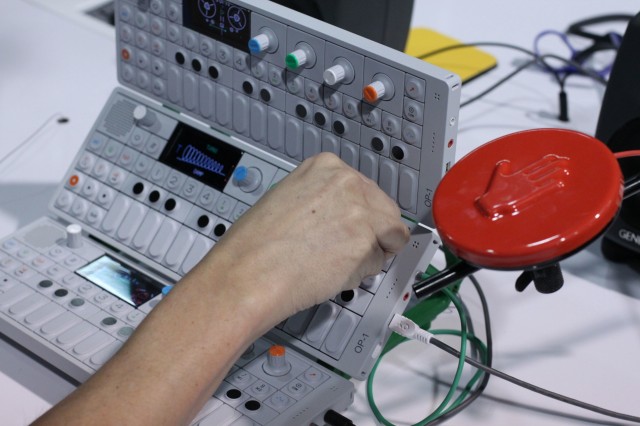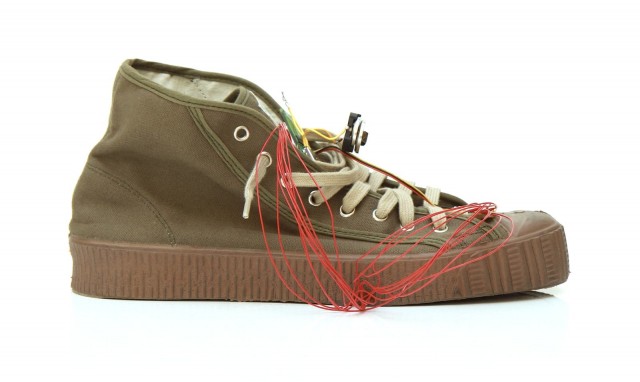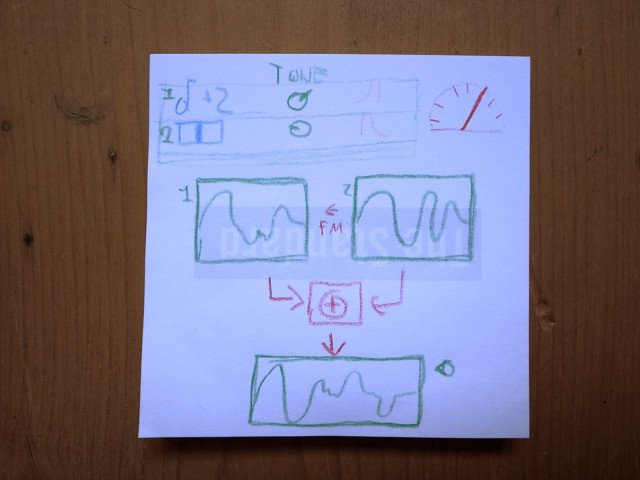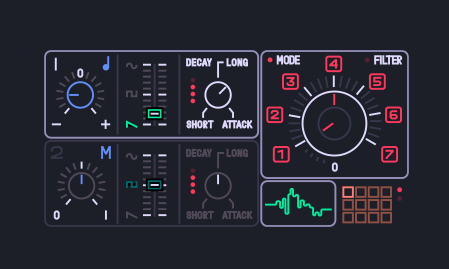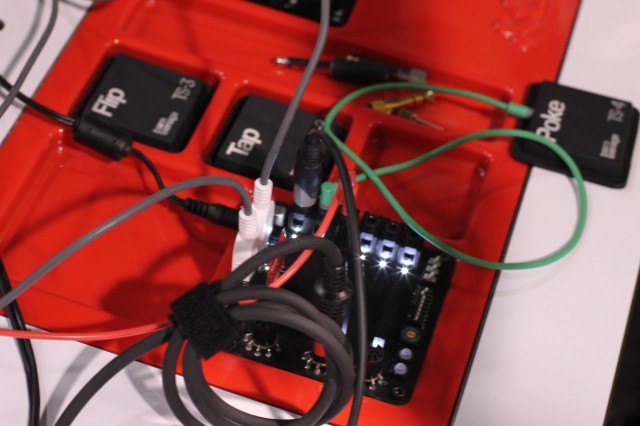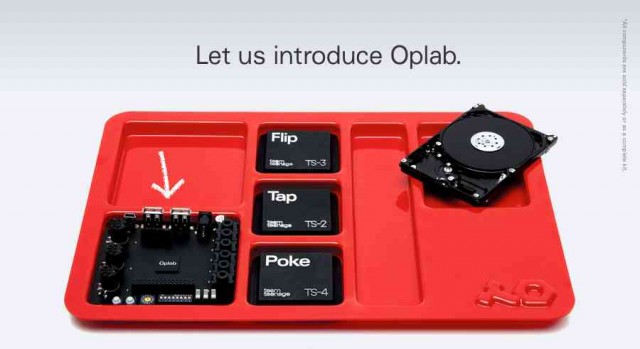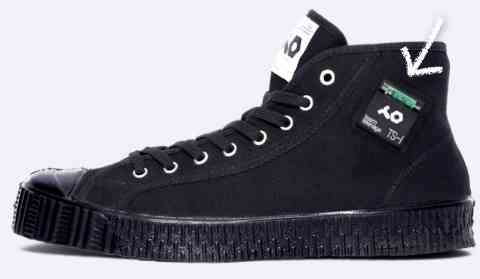Stockholm-based design technistas and boutique synth shop Teenage Engineering have evidently worked out how to keep busy and brighten those dark Swedish winters. They showed up in Southern California this week with a slew of new stuff to show off. And while mention of their OP-1 synth may elicit controversy in comment threads online, their booths are crowd pleasers. In contrast to the buttoned-up, business-like atmosphere of a lot of tech vendors at NAMM, TE’s whimsical science lab seems to spill out onto the show floor, and – along with more analog-tilted booths Big City and Analog Haven – attracted crowds like no other tech.
What was actually going on? There’s a new OS update and a new product. The OS update delivers new drum and sequencer modes and badly-needed MIDI sync, plus cool MIDI modulation. Combined, it seems the OP-1 has really matured – sync alone removes a major obstacle for some adopters.
The new hardware is Opbox, a combination USB host / MIDI / CV box with analog sensors – and it has pretty plug-in modules and even custom-made shoes to match. The shoes may not be terribly practical, but the Oplab fits a unique niche in hardware I/O and DIY projects – provided it’s a niche that people actually want. We’ve got some details plus some exclusive images.
OP-1 Update
New in the OS:
- Finger step-sequencer, with 32 step patterns per key and 14 polyphonic patterns. (It’s an unfortunate name, given that’s also Tim Exile’s excellent Reaktor creation. Toe? But it looks cool.
- DrumBox, a drum synth. More on that in a second.
- MIDI LFOs for modulating four parameters at once – very cool.
- MIDI sync – at last, you can sync to clock messages.
Bonus: you get Reason integration (if you enjoy superior Swedish engineering), and, oddly, a game.
http://www.teenageengineering.com/products/op-1/os-update
I ran into CDM reader Neil Bufkin on the show floor, and he’s back with a new video of the OP-1 update and other goodies. Watch:
Teenage Engineer David Ericksson also shares some thoughts with CDM on DrumBox:
The idea behind DrumBox is to provide a spiced up version of classic beat box designs with everything from digital wave-shaping to FM and more. You get 24 keys each with a custom 2 oscillator setup where you can morph between different modes. The same knob also includes a volume envelope to balance the drum sounds. It’s been very tricky to build this up using only 8 parameters and still get a versatile drum machine. The payoff is that it’s pretty hands on and when you start using the LFO’s to control these params you can really do crazy stuff.
TE also shares with CDM the rough sketch from which this feature originated, plus a look at how it looks in the final product:
Oplab
Oplab is an all-new product. It’s marketed as complementing the OP-1, but it’s really a general-purpose board. Imagine an Arduino-like prototyping platform on steroids, with stuff you’d want to use for music applications. And then imagine that, much to the surprise of me and a number of other people with whom I spoke, that they made a bare circuit board look strangely beautiful and finished. This board looks better than a lot of housings. In one box, you combine lots of I/O connections and inputs for sensors.
- Three USB connections. One turns the Oplab itself into a USB device, so you can connect to a computer. But the other two are USB hosts. That means you can use the Oplab with USB devices and no computer in sight.
- Three MIDI connections. MIDI IN, MIDI OUT, and then a third MIDI port that can be either THRU or SYNC24.
- 2 CV in, 2 CV out for analog connections – using any analog connection you like.
- Program select switches. Easy access to settings.
- Ins and outs for anything else. 2 12-bit connections can be switched to input or output, so you can do everything from add sensors to use as music controllers or drive lights or motors. Now, that’s not many connections – but notice also the headers and coming development kit.
- Plug-and-play sensors. For those who want something that lets them hack around without having wires pop up or worrying about delicate, exposed boards, TE is making ready-to-use sensors. Flip is an accelerometer, Poke a pressure sensor, and Tap a piezo. You could also make your own and save some scratch.
http://www.teenageengineering.com/products/oplab/
All of this goodness costs you – US$299 is the price for the board, sensors costs $49 each, and the pretty red tray with the sensors and board all put together top US$425. But you do get some fairly sophisticated functionality in the form of adding MIDI and CV and USB hosting. Hosting isn’t easy. This also opens up some new interconnections with devices like iOS and Android and the OP-1, since the USB hosts can negate the need for a dedicated computer for USB MIDI gadgetry.
In fact, it’s nice to see a polished, designed product that does this kind of DIY stuff; that’s something we had seen in past entries from vendors like Eowave but had largely fallen away in recent years. There’s just no question that if you’re on a budget you should look to other ways of doing this. And I think the bigger question is whether people will like this I/O setup. It won’t suit people with lots of CV, and it’ll be overkill for people with simpler setups. My guess is it’ll make a lot of people happy in between, but I honestly don’t know. Let us know if you’re intrigued.
All of this is capped off by more Teenage oddities. The latest addition: they’ve designed their own custom shoe, complete with a pouch to hold their accelerometer.
More information – and lots of ideas for how you might use the Oplab, put quite articulately if a bit scant on technical details – at:
http://www.teenageengineering.com/products/oplab/
http://www.teenageengineering.com/products/op-1/os-update
Updated: Making Over Your Lifestyle with Design
Comments are getting a bit … heated … below. So, I simply wish to take this opportunity to say, if you don’t like the chic design of Teenage Engineering’s products, you can be easily replaced.
(PS – IKEA is now based in the Netherlands, so it’s fitting this is a Dutch, not a Swedish, film. But watch and learn. Now, if you’ll excuse me, I’m going to pop open a can of Budweiser and use a real synth – one with wooden endcaps – in the back of my truck, before catching the NFC championship football game. None of this Swedish nonsense. And remember, all national stereotypes in your head are completely true! America!)
It bears saying: a lot of the taste for Scandinavian design was cultivated in the US. Along with other European modernists, key designers settled places like Los Angeles, and their style mingled with American style. If you don’t like the looks (or, crucially, function) of this, tell us what you do like: more variety is better.
